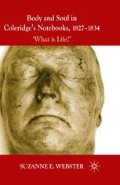Abstract
The notebook entries examined thus far have established three important things. The first is Coleridge’s admission that Body and Soul are both implicated in Sins ‘of’ and ‘in’ the Man, and that the physiological and psychological aspects of the human being are thus jointly implicated in any voluntary attempts made to expiate those Sins. Secondly, however, while recognising the Soul’s inclusion in the state of sinfulness, Coleridge perceived that the biggest hurdle to self-purification and -expiation lay in one’s ability to tame the sensual indulgences of the physiological Body. Evidence has shown that he placed the root of Sin and corruption within the physiological Body, and identified the mastering of the Body as a vital element in the human ability to control and tame Sin. The third thing established in the notebooks, though, is that while emphasising the role of the individual human in his process of expiation, Coleridge believed wholeheartedly that only the Grace of the Christ Jesus could fully expiate man of his Sins; and, in accordance with Christian teaching, the operation and receipt of this benediction depended upon Christ’s Incarnation.
Copyright information
© 2010 Suzanne E. Webster
About this chapter
Cite this chapter
Webster, S.E. (2010). The Crux of the Dilemma: The Incarnation, Humanity, and ‘Obnoxious Body’ of Christ. In: Body and Soul in Coleridge’s Notebooks, 1827–1834. Health, Technology and Society. Palgrave Macmillan, London. https://doi.org/10.1057/9780230245815_3
Download citation
DOI: https://doi.org/10.1057/9780230245815_3
Published:
Publisher Name: Palgrave Macmillan, London
Print ISBN: 978-1-349-36072-7
Online ISBN: 978-0-230-24581-5
eBook Packages: Palgrave Literature CollectionLiterature, Cultural and Media Studies (R0)

